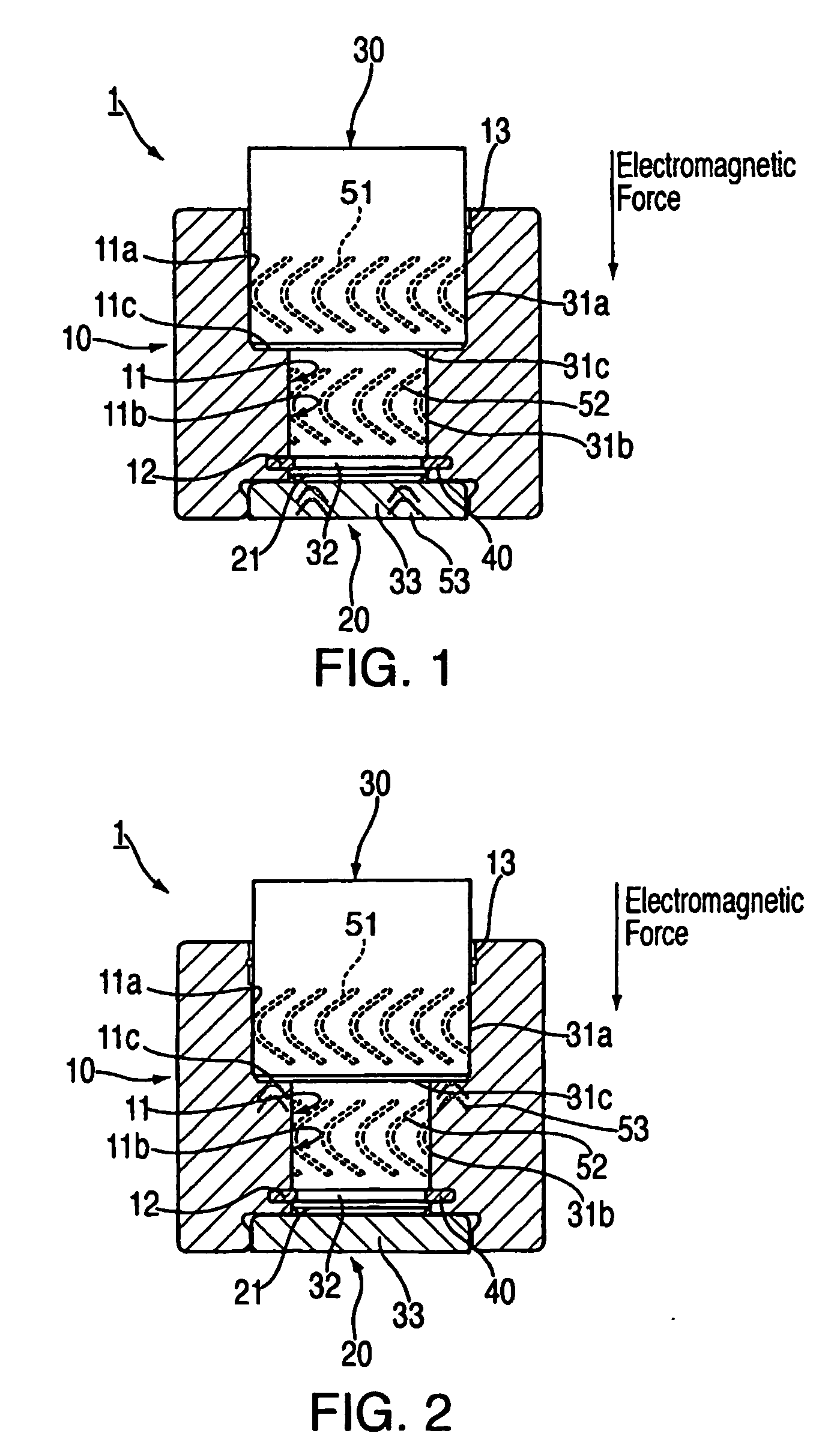Fluid Dynamic Bearing Mechanism
a dynamic bearing and bearing mechanism technology, applied in sliding contact bearings, instruments, record information storage, etc., can solve the problems of small shaft torque loss and lower power consumption, and achieve the effect of reducing shaft torque loss, improving rotation accuracy, and reducing power consumption
- Summary
- Abstract
- Description
- Claims
- Application Information
AI Technical Summary
Benefits of technology
Problems solved by technology
Method used
Image
Examples
embodiment 1
[0033]The first embodiment (Embodiment 1) of the invention in this application is described below.
[0034]FIG. 1 shows a vertical cross-sectional view of a fluid bearing system 1 of the first embodiment. The fluid bearing system 1 of the first embodiment is equipped with a cylindrical bearing case 10 having a cylindrical hole 11 (11a, 11b) in its center, an end plate 20 that seals one end of the lower part of the bearing case 10 and a shaft 30 that has at least one part inserted into and supported by the bearing housing formed by bearing case 10 and end plate 20. The cylindrical hole 11 consists of a large part 11a and a small part 11b. The shaft 30 is connected to the rotating load unit not shown in the figure. The shaft 30 may be manufactured as an integral part of the rotating load unit. Additionally, in some cases, a fixed unit may be attached to the shaft 30 in place of the rotating unit. In this case, the bearing case 10 is the rotating side. Furthermore, in this specification, ...
embodiment 2
[0046]FIG. 2 shows a vertical cross-sectional view of a fluid bearing system 1 of a second embodiment (Embodiment 2) of the invention of this application and the parts corresponding to Embodiment 1 have been assigned the same codes.
[0047]As shown in FIG. 2, when the dynamic fluid bearing mechanism 1 (alternatively, the fluid bearing system 1) of Embodiment 2 is compared to Embodiment 1, the only difference is in the position where the third dynamic pressure generating groove 53 is formed. In other words, while in Embodiment 1 the third dynamic pressure generating groove 53 was formed on the inner surface 21 of the end plate 20, in Embodiment 2, the third dynamic pressure generating groove 53 is formed on the step part 11c of stepped cylindrical hole 11 of bearing case 10. In addition, the small gap faced by said third dynamic pressure generating groove 53 and formed between the step part 11c of stepped cylindrical hole 11 and the surface of the step part 31c of stepped shaft 30, is ...
embodiment 3
[0053]FIG. 3 is a diagram showing a vertical cross-sectional view of the present invention's third embodiment (Embodiment 3) of a fluid dynamic bearing mechanism 1, with the same labels for the parts that correspond with Embodiment 2.
[0054]The fluid dynamic bearing mechanism 1 of Embodiment 3 has a gradient in the bearing case 10's step part 11c of stepped-cylindrical hole 11. A step part 31c of stepped-shaft 30 has a tapered structure (designated by label 31f), such that the smaller side is in the direction of endplate 20. The third dynamic pressure groove 53 is formed at a tapered part 11f of the stepped cylindrical hole 11. The annular ring 40 is moved on the large-diameter part side of bearing case 10. Alternatively, the third dynamic pressure groove 53 can be formed on the external surface of the tapered part 31f of stepped-shaft 30.
[0055]In Embodiment 3, the small gap (which faces the third dynamic pressure groove 53) that is formed between the tapered part 11f and the externa...
PUM
| Property | Measurement | Unit |
|---|---|---|
| diameter | aaaaa | aaaaa |
| dynamic pressure | aaaaa | aaaaa |
| forces | aaaaa | aaaaa |
Abstract
Description
Claims
Application Information
 Login to View More
Login to View More - R&D
- Intellectual Property
- Life Sciences
- Materials
- Tech Scout
- Unparalleled Data Quality
- Higher Quality Content
- 60% Fewer Hallucinations
Browse by: Latest US Patents, China's latest patents, Technical Efficacy Thesaurus, Application Domain, Technology Topic, Popular Technical Reports.
© 2025 PatSnap. All rights reserved.Legal|Privacy policy|Modern Slavery Act Transparency Statement|Sitemap|About US| Contact US: help@patsnap.com



